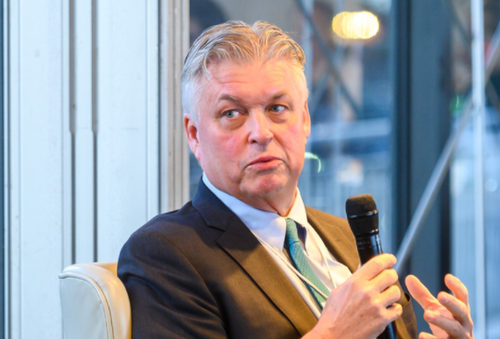Meet The Bank Of America Exec Accused Of Ruling Through COVID With An “Iron Fist”
Thomas K. Montag, Bank of America’s second in command, oversees about 17,000 people and still gets thing done in an “old school” kind of way.
Such was the topic of a new profile on Montag, that highlighted his business practices as inclusive of favoritism and “ruling with an iron fist”, according to the New York Times.
Montage was born in Portland, Oregon and started his career in 1985 at Goldman Sachs. He was a former offensive tackle for his high school football team before going on to work in swaps at a Goldman trading desk. In 2008, he joined Merrill Lynch to run its markets division, and was soon put in charge of the merger between B of A and Merrill. Anne Finucane, Bank of America’s vice chairman said: “The early days were certainly rocky, but he made it work.”
But divisions that Montag was in charge of “blossomed” and spoke to his ability to cultivate large clients. Some of his employees, however, found his expectations unreasonable:
On Friday afternoons over the years, after the markets had closed, Mr. Montag sometimes sought out floor managers at their desks, current and former employees said, leaving Post-it notes scrawled with the words, “Where are you?” if they weren’t around.
Montag would also routinely clip or add to bonuses for reasons that weren’t clear, at the last minute, employees said. Those who got additional bonuses were known as “FOT” or friends of Tom.
One FOT was Gene Reilly, a hedge-fund manager who worked for him as Bank of America’s global head of quantitative trading in the early 2010s. He told the NYT: “Tom really cares about people in an old school way that’s not typical in today’s corporate world. Whether a colleague needs heart surgery or someone’s parent is dying in the hospital, Tom makes the phone call and helps anyway he can.”
His old school style has led to sexual harassment within his divisions, however. “Montag’s divisions confidentially settled about 15 complaints annually” from employees who made “credible allegations of misconduct or a toxic work environment”. Bank of America spokeswoman Jessica Oppenheim called the number “grossly inaccurate”.
And the profile specifically takes exception with Montag’s handling of the pandemic – he was insistent in his employees still showing up to the office during the beginnings of Covid. These employees called themselves “warriors” who referred to those who stayed home as “tapped out”. At the time, “some of Mr. Montag’s workers grew fearful that if they didn’t go into the office, they would lose their jobs or their bonuses,” the report says. Those who didn’t show up were put on something called the “can’t be bothered” list – an idea he first developed in 2014 as “an annual roster of employees whose bonuses would be docked because they did not carry out administrative tasks such as participating in colleague performance reviews.”
All the while, Montag monitored the efficiency and profitability of employees who stayed home, versus those who came to the office, via spreadsheet. In essence, the piece notes, he “[kept] score”.
During the pandemic, the productivity spreadsheet, titled “Tom/Dashboard,” according to an image of it, allowed Mr. Montag to track individual profits and losses of employees working at home versus those still in the office, according to that and other images and two people with knowledge of the spreadsheets. In the office, said one of those employees, Mr. Montag would sometimes pop by individual desks and say, “I knew you’d be here.”
Montag himself went into the office in the early days of the pandemic, telling the NYT: “I was the battlefront for us in a way.” He would cycle into the office in jeans and sneakers every day instead of showing up in his usual coat and tie, the report notes.
As the second best paid executive at Bank of America, it’s a stark contrast from many other corporate COOs who are happy to collect their compensation and who are busy focusing on things like not offending their employees. Or, as the New York Times put it, the 64 year old’s “hard-driving approach has been increasingly out of step with the contemporary world of finance”.
While some describe him as shrewd and charismatic, other employees say his management style is “demanding and erratic”.
Robert Grillo, who was a managing director in the bond division of Bank of America from 2009 to 2016, said: “Tom demanded excellence. He was very motivational in speaking. He had an incredible work ethic. But his favoring of certain groups, and people, I think, was detrimental to the total culture.”
Compared to other banks, Montag was slower to embrace working from home during the pandemic. This resulted in attrition and slumping morale. “At least 11 senior markets employees, including several traders and some department heads, have left Mr. Montag’s divisions, along with the chair of global corporate and investment banking,” the profile notes.
More than 100 other people took layoff packages to exit while keeping their stock. The Times talked to more than 2 dozen current and former employees and found that the mood amongst them was one of “resignation”.
“They’re going to kick me out of here,” Montag said in February. Last July, he wrote to some of his employees: “I came to New York to make a few dollars, go back to Oregon, and buy a house. Everything else has been gravy.”
Tyler Durden
Sat, 05/15/2021 – 18:00![]()
Zero Hedge’s mission is to widen the scope of financial, economic and political information available to the professional investing public, to skeptically examine and, where necessary, attack the flaccid institution that financial journalism has become, to liberate oppressed knowledge, to provide analysis uninhibited by political constraint and to facilitate information’s unending quest for freedom. Visit https://www.zerohedge.com

